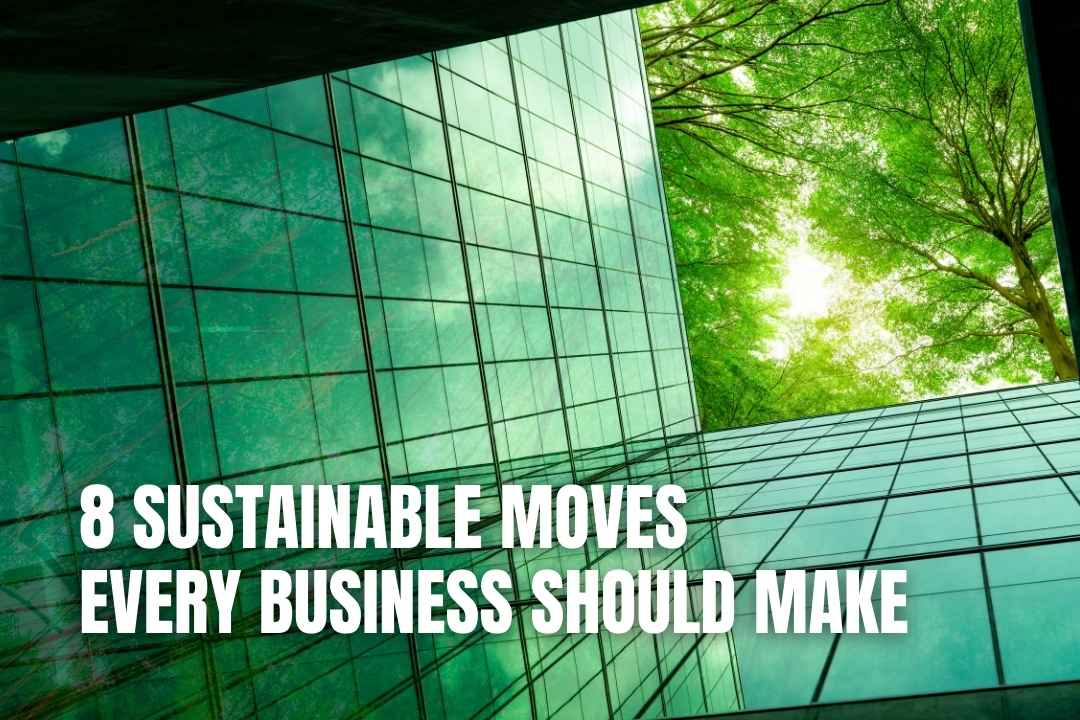8 Sustainable Moves Every Business Should Make
August 14, 2025

Sustainability isn’t just a trend anymore. Customers expect it, investors like it, and frankly, the planet needs it. The good news is, you don’t have to be some massive corporation with unlimited funds to make it happen. Whether you’re running a local café, a retail store, or a growing online brand, there are steps you can take to make your business greener without it becoming a huge headache. It’s not about doing everything perfectly from day one, but about making small, consistent changes that actually add up. Here’s where you can start.
Key Takeaways: 8 Sustainable Moves Every Business Should Make
- Reduce energy waste: Switch to LED lighting, use timers, optimise heating and cooling, and take advantage of natural light to cut costs and emissions.
- Go paperless where possible: Adopt digital invoices, receipts, and contracts, and if paper is needed, choose recycled materials and eco-friendly ink.
- Choose greener suppliers: Partner with suppliers who use renewable materials, reduce waste, and have ethical practices to extend sustainability beyond your business.
- Improve building efficiency: Upgrade insulation, windows, and heating/cooling systems; consider an EPC assessment to identify efficiency improvements.
- Cut down on packaging: Use recycled or compostable materials, reduce packaging volume, and encourage reusable options for customers.
- Offer repair or reuse options: Provide repair services or reuse schemes to reduce waste, increase customer loyalty, and demonstrate responsibility.
- Make travel greener: Shift to electric/hybrid vehicles, promote cycling or walking, allow remote work, and consolidate deliveries to lower emissions.
- Involve your team and keep improving: Engage employees in sustainability ideas, measure progress, and continuously adopt new practices without aiming for perfection from day one.
Register Your LLC
Company Registration
START NOWReduce energy waste
If there’s one easy win, it’s cutting down the energy you waste every day. That could mean switching to LED lighting, installing timers so you’re not leaving things on overnight, or simply making the most of natural light instead of blasting the overheads. It’s surprising how much of your monthly bills come from things running when nobody’s even using them. Heating and cooling systems are also big energy drains, so keeping them serviced and running efficiently can make a big difference over time. Not only will you save money, but you’ll be reducing your footprint without even thinking too hard about it.
Go paperless where possible
In an age where almost everything can be stored, signed, and shared digitally, sticking to old paper processes is just creating waste. It’s not about banning paper completely, but about asking yourself if that printout is really necessary. Digital invoices, receipts, and contracts are just as valid and often faster to process. If you need to keep physical copies for certain records, try to use recycled paper and eco-friendly ink. Over the course of a year, even cutting your paper use by half can have a big impact on both your costs and your environmental impact.
Choose greener suppliers
You can make changes inside your business, but you can also influence the chain you’re part of. Working with suppliers who care about their own environmental impact is a way to extend your sustainability efforts beyond your own walls. Look for those who use renewable materials, have ethical working practices, and don’t waste resources on excessive packaging. It might cost a little more in some cases, but it’s worth weighing that up against the long-term benefits for your brand reputation and the planet.
Improve your building efficiency
If your business operates from a physical space, the building itself plays a huge role in how sustainable you can be. Proper insulation, efficient windows, and modern heating or cooling systems can make a big difference to your energy use. In many cases, businesses also need to ensure they meet certain regulations, and this is where a compliant EPC can help you see exactly where improvements could be made. It’s a straightforward way to get a clear picture of your building’s efficiency and where you can save both energy and money.
Cut down on packaging
One of the easiest ways to create less waste is to look at the packaging you use, especially if you’re selling products. Can you swap plastic for recycled cardboard or compostable materials? Could you reduce the amount of packaging altogether? Customers are increasingly drawn to brands that ship products in simple, eco-friendly ways. Not only does this reduce waste, but it also makes you stand out as a business that’s actively thinking about the planet. If you run a local business, encouraging customers to bring their own bags or containers can also cut waste dramatically.

Offer repair or reuse options
If your business sells products that could be repaired instead of replaced, offering a repair service is a fantastic way to reduce waste while also keeping customers loyal. The same goes for reuse schemes, where customers can return items or packaging to be cleaned and used again. This doesn’t just help the environment — it also shows your audience that you’re willing to take responsibility for what you put out into the world. It’s a small change that can have a big knock-on effect on how people see your brand.
Make travel greener
Business travel, whether that’s deliveries, site visits, or commuting, can add up to a lot of carbon emissions over time. Switching to electric or hybrid vehicles where possible can make a noticeable difference, and for shorter trips, encouraging cycling or walking can be a bonus. If your business doesn’t need people physically in the office every day, offering remote working a few days a week can cut down on commuting and keep your team happier at the same time. Even consolidating deliveries to reduce the number of trips can help bring down your impact.
Involve your team
Sustainability works best when it’s something your whole team is on board with. This isn’t about handing down rules from the top but about getting everyone involved in coming up with ideas and making changes. You’ll often find your staff have great suggestions on how to reduce waste or save energy that you hadn’t even thought of. The more people feel included, the more they’ll take ownership, and that’s when it becomes part of your everyday way of working instead of a box you’re trying to tick.
Keep improving
The thing about sustainability is that it’s not a one-and-done deal. There’s always going to be something new to learn, a better way of doing things, or a fresh technology that makes your processes cleaner. The key is not to get overwhelmed. Start with a few easy wins, measure how they’re working, and then look for the next step you can take. Over time, those small changes build up into something much bigger, and you’ll see the benefits in your reputation, your running costs, and the impact you have on the environment. It’s not about being perfect — it’s about being better than you were yesterday.
Sustainability doesn’t have to be complicated or expensive, and it’s not just for big companies with huge budgets. Every small change you make adds up, and the sooner you start, the more impact you’ll have. The bonus is that going greener often saves money and builds trust with your customers, so it’s a win on every front. The important thing is to keep moving forward, even if it’s one step at a time. Before you know it, you’ll be running a business that’s better for both your bottom line and the planet.
FAQs
How can small businesses start becoming more sustainable?
Begin with simple changes like reducing energy waste, going paperless, and switching to eco-friendly packaging. These steps are low-cost and have an immediate impact.
Are sustainable changes expensive to implement?
Not necessarily. Many actions, like switching to LEDs or reducing waste, save money over time. Partnering with greener suppliers may cost more initially but offers long-term brand and environmental benefits.
What role do employees play in sustainability?
Employees can provide valuable ideas for reducing waste and improving efficiency. Involving them fosters ownership and ensures sustainability becomes part of daily operations.
How can travel-related emissions be reduced?
Use electric or hybrid vehicles, promote cycling or walking for short trips, offer remote work, and consolidate deliveries to limit unnecessary journeys.
Why is continuous improvement important in sustainability?
Sustainability is ongoing. Regularly reviewing and upgrading practices ensures you adapt to new technologies, regulations, and opportunities to lower your environmental impact.

